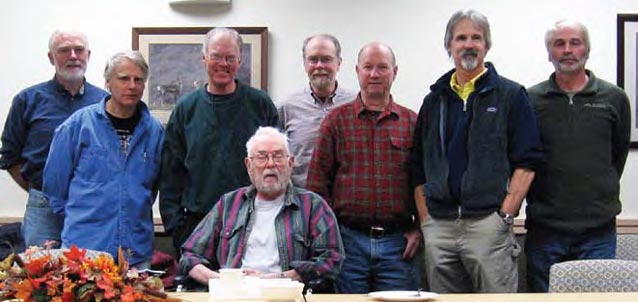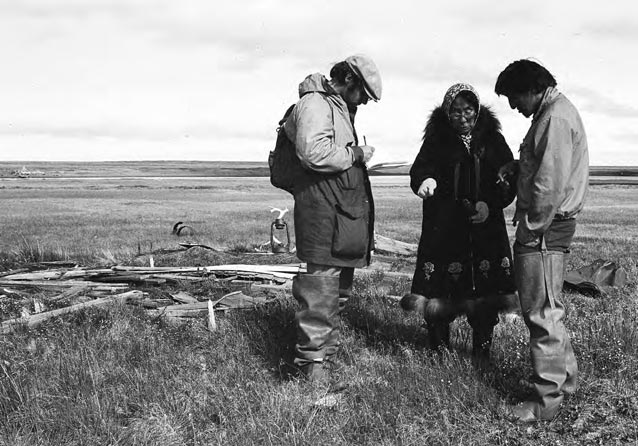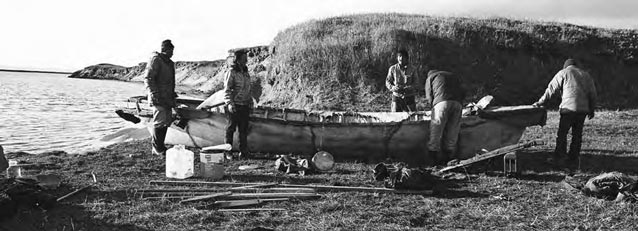Conducted by Frank Norris

Becky Saleeby
In early 2005, historian Frank Norris asked Mr. Bradley a series of questions about his career as it related to the Anthropology and Historic Preservation (AHP) Program at the University of Alaska Fairbanks’ Cooperative Park Studies Unit. The questions and answers below have been edited for clarity and brevity.
What brought you to Fairbanks and the university campus?
I began my NPS career as a seasonal ranger archeolo-gist at Canyon de Chelly in 1948, and in 1953 I accepted a permanent position at Tuzigoot [both in Arizona]. Beginning in 1963, I worked in Washington, D.C., as the agency’s Assistant Chief Archeologist and Chief of Park Archeology under John M. Corbett. But as time went on, I tried to get transferred back to the field, and in 1972, I was finally transferred to Alaska as head of the Cooperative Parks Study Unit at the University of Alaska. Several circumstances came to a head to hasten that transfer. First of all, it was recognized that with the discovery of oil on the North Slope that there were going to be lots of changes in the state, so in 1970, several teams were sent to Alaska to check out cultural resources that the service might be interested in. One of those teams consisted of me and two historians, Merrill Mattes and Reed Jarvis. After spending most of the summer in Alaska I fell in love with the country and asked Assistant Director Ted Swem for the chance to return.
More specifically, I came to Alaska because of the actions of NPS’s director at the time, George Hartzog. At some meeting in Washington, Hartzog ran into Vide Bartlett, the widow of Alaska Senator “Bob” Bartlett. Vide served on the University of Alaska’s Board of Regents and she handed him a torn piece of paper on which she had written in pencil, “The University of Alaska needs an archeologist in its anthropology Department. Can you supply one?” Shortly afterward, I was on my way to Alaska.
When did you arrive in Fairbanks, and did you begin to organize the CPSU right away?
I arrived on campus in the spring on 1972 and immediately got the CPSU Archeological and Historic Preservation (AHP) program going. I brought my family up later. Getting the program underway wasn’t much of a chore since I had arranged for the transfer of sufficient funds to ensure some field work and to make sure that the other Federal land managing agencies knew there was an office in Alaska to handle their archeological problems. (At this time other agencies did not have their own staff archeologists and relied on the NPS.) Part of the agreement I worked out with the university, and which was approved by the regional office in Seattle, included the arrangement that I would serve as an adjunct professor and would teach classes on cultural resources management at their request as payment for office and laboratory space they would provide. But before long, my teaching load was limited to field techniques for site survey and excavation as we went into our summer activities, so 95% of my time was related to the NPS.
At first, I had to share an office in the Anthropology Department until the new Gruening Building was completed. I then got not only office space for my crew, but lab space as well.
When you arrived at the University of Alaska, were there CPSUs at any other schools?
The CPSU at the UAF was a new creation as far as the name goes… There were no other CPSUs. However, the NPS Division of Archeology did have several associations with various universities such as the Southeast Archeological Center which I had set up at Florida State University for underwater archeology. We also had the Midwest Archeological Center associated with the University of Nebraska, and the University of Arizona helped operate a Ruins Stabilization Unit and associated archeological activities.
For the life of me, I can’t remember where the name “CPSU” came from. Somehow, I think it was Director Hartzog.
Was everyone that was funded by a CPSU contract a University of Alaska student, or were there students from other schools (or from outside of academe) as well?
The Department of Anthropology/Archeology at the UAF couldn’t supply the necessary personnel to carry out the programs so I recruited far and wide. Historians Robert Spude and Melody Webb, for example, were NPS employees; Melody, in fact, was my new hire.
There was no problem recruiting faculty and/or students to work on projects. Word was passed out to anthro departments all over the country, and I was inundated with applications. I had grad students and seniors from Arizona State, Colorado State, Washington, Oregon, UCLA, New Mexico, North Carolina, Evergreen College and other institutions, and of course UAF. More than 120 people participated in the AHP program over the years, almost all of whom went on to professional positions in either state or federal offices. But not all of my field researchers were out of academia. Bob Uhl, living a subsistence lifestyle in the Noatak area with his Eskimo wife Carrie, took on two research projects in the Cape Krusenstern/Noatak area. And both Ray Bane, a Bureau of Indian Affairs (BIA) school teacher in the village of Hughes, and Nita Sheldon, a Native Alaskan from Shungnak, helped with the Kobuk subsistence study.
How were the CPSUs funded? Were there line-item NPS budget items that were directed to UAF (and to other universities that had CPSUs)?
I don’t know about the other, later CPSUs, but I was recipient of line item funding that I arranged before leaving the Washington office. There was little or no over-view of my function by outsiders; both Washington and the regional office left all arrangements to me.
What were the initial studies undertaken as part of the Anthropology and Historic Program?
Some of the first work in the program was part of the team I led, called Team 5, that looked into the cultural resources that could be included in potential new park areas. Our team consisted of a crew of four archeolo-gists (Bob Nichols, Fred Bohannon, Gilbert Wenger, and Charles Voll) and one biologist (Bruce Moorehead); we worked with the other four teams supplying them with needed information. I also worked at Cape Krusenstern to get all the major archeological sites identified so we could get them in the proposed new park. I also had excava-tions going on, through UAF contracts, at Dakah De’nin’s Village on the Copper River, to ascertain its value for inclusion in Wrangell-St Elias; work also took place at Point Hope, and with Don Dumond from the University of Oregon salvaging a site in Katmai. Later we were asked to do a lot of work under the so-called 14(h) program, which identified historic and cemetery sites significant to Alaska Native peoples. One of the first major contract studies was with Brown University for the subsistence study along the upper Kobuk River; this study, Kuuvanmiit: Traditional Eskimo Life in the Latter Twentieth Century, was headed by Dr. Richard Nelson and was published in 1977. Other his-torical, archeological, and subsistence studies came later.
How long did the UAF CPSU last, and when was it most active?
The CPSU lasted from 1972 thru 1983. I retired in 1981, but the unit was ably run by Bruce Ream for more than a year after that on monies that had been stockpiled in the UAF bank. I don’t remember the year of greatest funding but it must have been in the late 1970s, when my budget reached almost $3 million, and I had some twenty-three to twenty-five individuals in the field.
I hasten to add that not all funding of CPSU projects came from federal funds. On one occasion at least I got a National Geographic Society grant for early man studies in Bering Land Bridge and at the Dry Creek Site beside Denali. This work was carried out by Roger Powers from the UAF Anthropology Department. The fact that Connie Wirth (an ex-NPS Director) served on the NGS board didn’t hurt.
Given the funding levels you received, how were projects selected?
For the most part I selected the projects and secured the funding. The only exception was the 14(h) program. For 14(h) there was a line item in the park service budget for, I think, about $800,000, approximately three-quarters of which was available for use in the field. Congress had originally put 14(h) in the budget of BIA, but when they learned that there was no professional anthropological or historical staff in BIA, they quickly put the program in our laps.
Were most of the studies that were funded by the CPSU an important part of a graduate student’s academic program?
In a 1980 report I co-authored with Fred Dean for the university, we stated that there were 7 master’s degrees that came out of the CPSU program, and 12 other individuals were working toward degrees at that time. I can’t remember how many of these students were in my program or in Fred Dean’s, but my best recollection is that few if any of the AHP students performed their studies as part of higher degree work. However, all archeology students had to have at least one season of field work, under a professional, before they graduated with a BS degree.

David Libbey
It appears that there were some 35 to 40 published studies that were completed by the CPSU’s Anthropology and History Preservation program. Were there any other end products from this program?
Yes, there were dozens of other studies that were never published or distributed for one reason or another. For instance, under 14(h), we produced over 8,000 reports of historic sites and cemeteries that Native corporations could select as part of their land holdings. Besides written materials there were also dozens of tape recordings of Native myths, religious stories and other ethnological materials. I should also mention that we put out a monthly, widely-distributed newsletter called “Z’s Briefs” reporting on research activities and results. A couple of years ago I received a letter from the UAF stating that they had at long last catalogued all the materials from CPSU and that they took up 28 linear feet of shelf space in the Alaska and Polar Regions section of the library.
Given the enormous public lands issues going in Alaska during the 1970s, did some of the studies you produced have a political purpose? Were they read by Congressional staffers, by NPS leaders in Washington, and others who were fighting for, and trying to justify, the various proposed park boundaries? Or were they primarily of scientific/academic interest?
The NPS used the documents to show the diversity of cultural resources in the proposed park areas, but they were not used in the real political sense of pushing for the inclusion of the areas in the park system. It was more like introducing members of Congress and the Interior Department personnel to what we had in Alaska. They were documents primarily of scientific interest.
Considering all the fieldwork involved, was safety ever an issue?
In eleven years of field work in often rugged conditions, the most serious injury we suffered was a badly sprained ankle and several heavy bruises. This was despite a float plane that flipped while landing in a lake in the Bering Land Bridge area and a chopper that went down in the Seward Peninsula with several people on board. There were several close encounters with bears. But there was only one fact-to-face challenge. In Southeast Alaska, one crew member climbed a tree to get away from a black bear; the bear came up behind him, but the worker ran it off by firing a flare in its face. Some people also got dumped out of a boat, but they only got wet.
Did the direction of the CPSU change after ANILCA was signed?
Actually there was very little change in CPSU funding after December 1980, when ANILCA became law. There was still a basic need for archeological and historical information. One change was a slow down in requests for help by other federal agencies, because at long last they were getting their own professional archeological and historical staffs.

David Libbey
Why was the CPSU at UAF terminated?
The end of CPSU was brought about primarily by John Cook, the NPS’s Alaska Regional Director. John, as a former assistant director, had close ties to the program. So it was a big surprise one day when I learned that John had rejected receipt of the 14(h) funds and instead directed them back to the BIA, even though the agency didn’t have the professional staff to carry out the program. The loss of this funding was not the end of the UAF CPSU per se, but after this action, I decided to take my retirement after some 35 years of federal employment. And after I did so, he canceled all funding for the UAF operation and instead directed these funds over to the regional office where a Division of Cultural Resources was being formed.
To see all 38 reports pubished by the Anthropology and Historic Preservation Unit, go to www.nps.gov/akso/docu-ments/AKcpsubiblio.pdf
Part of a series of articles titled Alaska Park Science- Volume 8 Issue 1: Connections to Natural and Cultural Resource Studies in Alaska's National Parks.
Tags
Last updated: August 10, 2016
